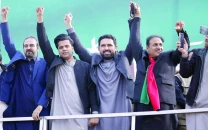Is the United States looking for middle ground?
The US has already de-escalated its controversial drone campaign; about 11 strikes in over five months this year.

Drones have certainly set dangerous precedents, also because the Obama administration still considers them useful and thus a legitimate tool against anti-US elements. PHOTO: FILE
Confronted with hard choices ahead of next year’s presidential election, and the drawdown of its troops in Afghanistan – the Obama administration is desperately looking for ways to facilitate its Afghanistan-related strategy.
As a quid pro quo, the US has already de-escalated its controversial drone campaign; about 11 strikes in over five months this year, compared to 50 drone attacks between January 1 and December 31, 2012 killing 378 people (according to ministry of interior figures).
But the figures for 2013 provide a sharp contrast to what happened in previous years; if we were to take out the eight or so strikes between 2004 and 2006, the average attacks off pilotless aerial vehicles for five years between 2008 and 2012 comes close to 67, or 5.56 per month. But the story for the first five months of 2013 is substantially different. Does it reflect a possibly more cautious and calibrated approach by the Central Intelligence Agency (CIA) in deference to the growing chorus of criticism? Has the Obama administration instructed a de-escalation in the predator campaign to appease the Pakistani leadership? Or, is the United States now looking for a middle ground to meet with impending challenges from an embattled Afghanistan, and an increasingly erratic Afghan President Hamid Karzai?

If yes, will this mitigate the primary concern, which is the violation of Pakistan’s territorial sovereignty? Will this happen despite reduced ferocity in the drone campaign? Certainly not. Or, if these attacks came to a halt altogether, will the Pakistan army be able to hunt down terrorists holed up in Waziristan?
United Nations’ officials as well as analysts and ex-security officials in the US and the UK are looking at the issue from the international law perspective, rather than judging it from the utility perspective. They are also seized with the spectre of another country, say, India, using the same technology by invoking the pretext of “terrorists camps inside Pakistan,” or Pakistan launching such preemptive strikes against persons/groups considered detrimental to Pakistani interests.
Drones have certainly set dangerous precedents, also because the Obama administration still considers them useful and thus a legitimate tool against anti-US elements.
While, practically, the issue of legality and utility now seems settled and beyond dispute, with a general acceptance that the use of unmanned lethal weapons against targets on a foreign country violates its sovereignty. At the same time, drones do target elements that represent a threat to Pakistan as well as the US and its allies. Yet, the major challenge confronting both the United States and Pakistan is to find a mechanism which apportions part of the drone strikes’ responsibility to Pakistan.
Can the Nawaz government bridge the gap between its opposition to drones and the need for hunting down elements hostile to peace? How can administrations reconcile the need for ensuring respect for Pakistan’s sovereignty with the pressing need to ride out of the country’s enormous difficulties, and the compulsions that a United Nations membership places on Pakistan?
Of course, the government must convey to the US that the presence of al Qaeda linked foreigners does not justify undermining Pakistani sovereignty. Neither can a unilateral CIA strike be legitimised in the name of US interests alone as the CIA cannot, and must not, be seen as protecting US national interests by trampling Pakistanis interests.
This context confronts both Washington and Islamabad with the most formidable challenge of finding the middle ground that is absolutely essential for the $7 billion drawdown of US-led international troops from Afghanistan via Pakistan.
Published in The Express Tribune, June 14th, 2013.



















COMMENTS
Comments are moderated and generally will be posted if they are on-topic and not abusive.
For more information, please see our Comments FAQ